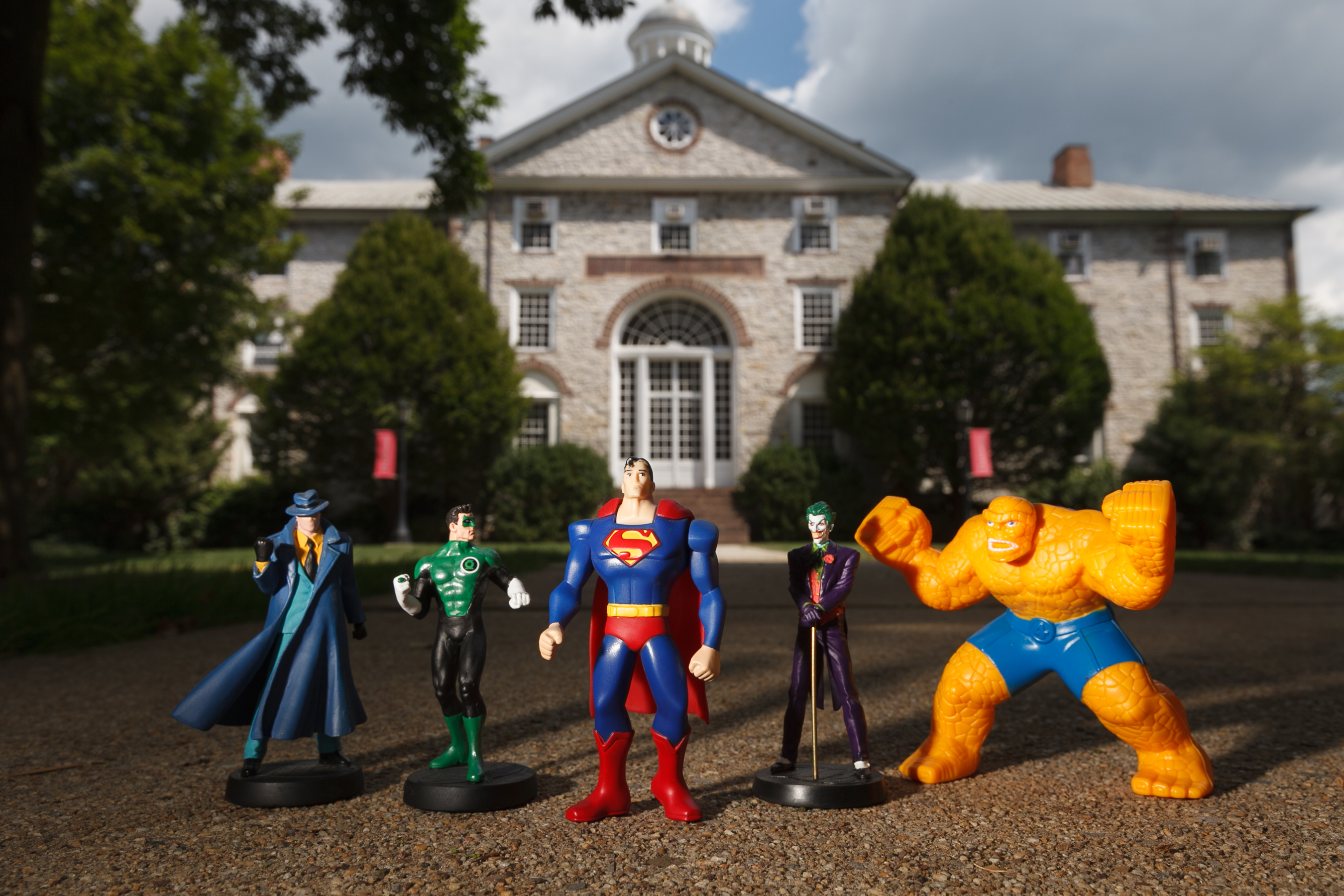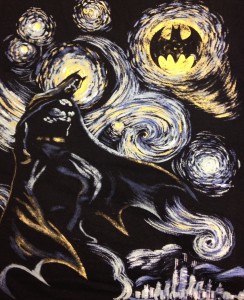During the summer months, Dickinson College’s campus is largely uninhabited, save for a small collection of staff members, faculty, and students. So when folks who saw me at the college then asked me to explain why I chose to spend my vacation from the academic halls and the library—where I exhausted countless hours studying, writing papers, and snacking on Kashi granola bars and Chobani yogurt cups (I admit that I am among the few who survives without caffeine)—back in those spaces, you might imagine, reader, that I felt motivated to offer some spectacular response. To satisfy most inquiries, saying very plainly “I’m doing research on comic books” was an exciting enough phrase.
In the presence of interrogators who possessed stronger senses of doubt, though, I needed to elaborate in order to show them that research on comics is a real thing; “Greg Steirer, a professor in the English department who taught of few of the classes I have taken, is writing a book with Alisa Perren, a professor at University of Texas at Austin, about the relationships between Hollywood studios and American comic book companies,” I would start.
“What got you interested in that topic?” one questioner asked at some point.
“I haven’t read many comic books and generally enjoy films, but what interests me most is my professor’s approach: he intends to move away from looking at the language, be it words or images, of comics and focus on how they function as products of industry: titles and symbols are trademarks, characters are copyrighted properties, and markets change as printing and film technology becomes more sophisticated,” I typically responded.
“Oh, so you won’t be comparing stories to their adaptations?” another interrogator asked.
“Only if the differences revealed through that kind of comparison affect the legal actions carried out by a company or studio, the money earned by comics artists and directors, producers, etc., adaptations for television, spin-offs, or the promotions and selling of ancillary products like toys, clothing, DVDs, and video games,” I have replied.
“You know, I have not thought about it much before now, but I have noticed a ton of comics-related things around within the last few years. I can see how you could learn a lot using that kind of approach,” the freshly convinced admitted.
Though I experienced several a-ha moments of my own as I was working on my project, many of them were similar to ones I witnessed others having: there existed this shared notion that comic books as well as films and merchandise inspired by comics have been a part of American popular culture for a while, yet the fact that this phenomenon would be examined in academia is generally surprising.
“Where Did You Begin?”
My first task was to familiarize myself with the terms in use within the works that discuss comic books. Effective research addresses the basis of knowledge about a topic or field that is maintained by a particular academic community before covering new ground, by using either traditional methodologies to add information to that basis or by suggesting that different tools be implemented to expand the breadth of the topic. To do this, I looked to two texts—Jean-Paul Gabilliet’s Of Comics and Men: A Cultural History of American Comic Books (2013) and Sean Howe’s Marvel Comics: The Untold Story (2012)—that Professor Steirer assigned to me in order to gain a better sense of the history of comics as a medium and some of the prominent comic book artists who helped keep the art form alive (with some attention to its place within film, television, and other entertainment industries). Gabilliet’s book offers a comprehensive, yet not exhaustive, description of the birth and evolution of comics, highlighting different eras in which comic books were marked as pure entertainment, censored for being detrimental to the lives of American youth, hailed as art, and acknowledged as forums for ideological agendas.
Howe’s book focuses on the story of the founding and growth of Marvel Comics, one of the largest comic book companies to date, describing the artists, writers, corporate heads, organizations, and families involved in the creation of iconic characters, the most popular of whom are superheroes like Spiderman, Iron Man, Elektra, the Fantastic Four, Captain America, and the Incredible Hulk. Using personal interviews, recorded conversations, letters, and hearsay, Howe presents the company’s moments of decline and extreme commercial success during the Golden (late 1930s to the early 1950s), the Silver (late 1950s to around 1970), the Bronze (1970 to 1985), and portions of the Modern Ages (1985 to the present) of American comics. It is during this latter phase of time that comic book companies in the United States begin to integrate with Hollywood studios in order to build franchises around popular characters that inspire the development of ancillary products and allow both industries to thrive.
While I was reading through those books, Professor Steirer also shared with me his essay “The State of Comics Scholarship: Comics Studies and Disciplinarity,” in which argued that there is no established academic community for comics scholars and hence little opportunity for debate about what methodologies are to become standard and what theoretical direction ought to be taken within comics studies. He goes on to say that most of the research produced about comics either presents facts about the medium or puts forth critiques about the language within comics, their implicit ideological pretenses, authorship, the medium’s effect on readers (i.e. fan culture, social studies on children), and the comic book’s place as a commercial entity.
As a result of the prevalence of these kinds of isolated analyses, “comics studies” is often grouped together with traditional academic fields like literary studies, culture and media studies, and American studies rather than treated as its own discipline. Without any formal disciplinarity attributed to itself by comics scholars, research on comics does not have its own institutional locus. The solution to this lack of administrative organization and clarity of objective that Steirer offers redirects scholars’ attention to the fact that comic books were first printed to satisfy one goal: to earn money and continue selling products. Companies like Marvel, DC Comics, Image Comics, and Dark Horse have helped turn comics into a fully-fledged and continuously expanding industry. What is more, the Modern Age of American comics would likely have already ended and comics would largely be obscure by now if most comic book publishers did not combine forces with Hollywood studios such as Warner Bros., Sony, Disney, 20th Century Fox, and Universal Pictures, among others.
Both comic book companies and film studios in the United States now share the more sophisticated goal of mass-producing popular and accessible fare that is franchise-able. Thus, Professor Steirer identifies the industrial approach to the study of comics as the most productive mode of analysis on the subject of comic books because of their relationship to issues like production, marketing, consumption practices, and intellectual property law and because of the success of this approach in film and media studies. He does reference some examples of comics scholarship that explore texts through this lens, but he explains that these few pieces exist in the margins of an already marginalized scholarly space.
“What’s in the ‘doing’? What were you looking for?”
After I had finished reading through the basis of knowledge on comic books and comics studies, I was better equipped to search for information directly relevant to Professor Steirer and Professor Perren’s book. Since industry-oriented scholarship on comic books is not a common approach, the sources of information about deals between publishers and studios, legal battles over the copyrights on a particular character or name, and advertising techniques used to promote comics, movies, and ancillary products is buried, so to speak, in non-scholarly articles, reports, and databases. I was tasked with the job of searching through the digital archives of the trade magazine (a general resource for news targeted toward people working in a particular industry) known as Variety, which publishes articles about issues related to Hollywood. I sifted through roughly a thousand separate pieces using search terms like “Marvel Comics,” “Avengers movies,” “Batman,” and “comics and television” in order to find reports that could give Professors Steirer and Perren a greater sense of how issues within these industries are handled tonally in comparison to legal documents and other online forums that mention comic books, movies inspired by comics, or the individuals involved in the processes that maintain these industries’ activity and influence their success. I compiled these writings into a digital annotated bibliography that can be viewed at any point of the book project’s development. Currently, there are over 300 applicable entries listed and summarized.
“What have you gained from this experience and where do you go next?”
Professor Steirer and Professor Perren’s book is scheduled to be published a few years from now, so the work I completed for them was rather simple compared to the work that is going to need to be done at the later stages of the project. However, Professor Steirer and I have discussed the prospect of our picking up where I left off next year. Aside from the large amount of knowledge I have learned this past summer, I have discovered an interest in research and at the moment have not ruled it out among my post-graduation goals. Also, as a student who now has worked and studied using both techniques typically utilized in literary studies and those that are more unconventional, like looking at the commercial or industrial issues, I have become much more aware of and sensitive to what common words like “book,” “art,” “study,” and “American” can mean.


Leave a Reply